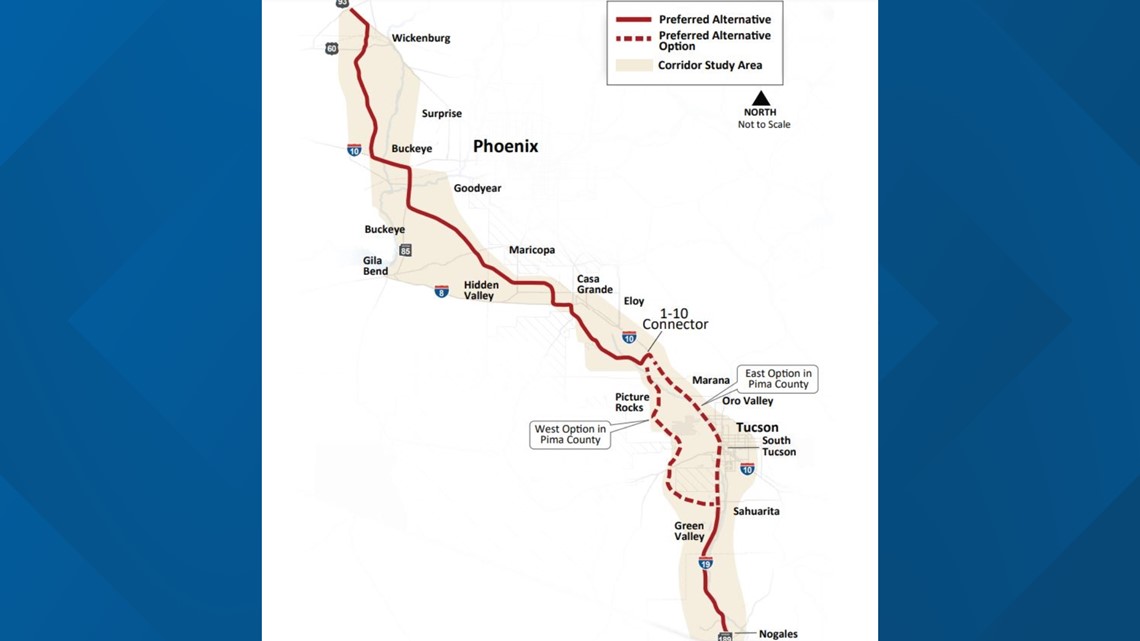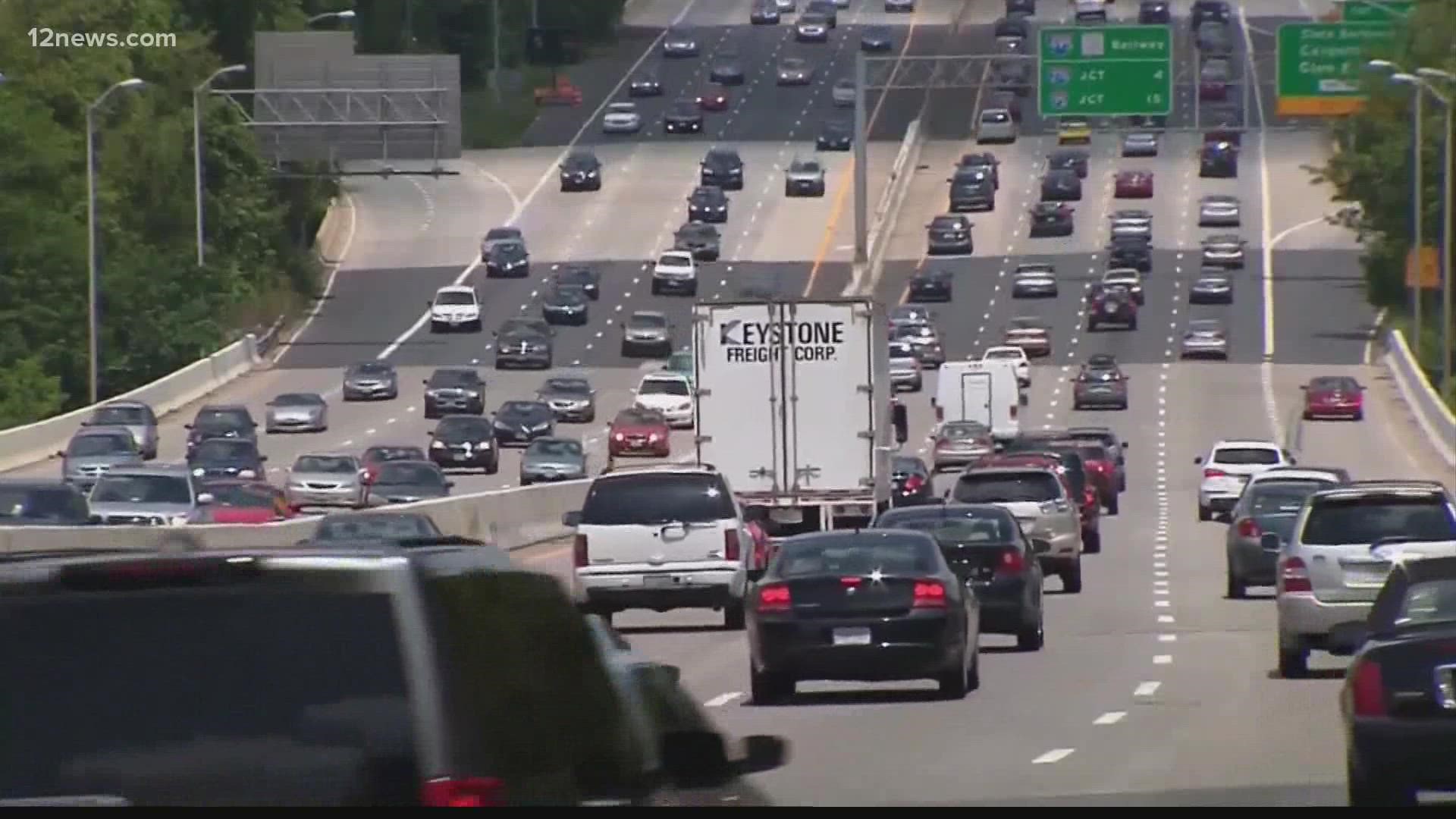PHOENIX — Editor's Note: The above video is from an earlier broadcast.
A new freeway connecting the U.S.-Mexico border to Las Vegas has been a pipe dream in Arizona for the last decade.
Politicians have espoused the perks of building more infrastructure, many community meetings have been held, and yet the proposed Interstate 11 freeway still might be years away from further development.
But in November, the Arizona Department of Transportation published the results of its years-long Tier I study that outlined a 280-mile corridor for where I-11 could be built between Wickenburg and Nogales.
The 2,000-foot-wide route descends down to Buckeye, snakes around the Sonoran Desert National Monument, cuts through land south of Maricopa, then moves south down to Pima County.
Identification of the route marked a significant milestone in the project's history but it has still left some questions unanswered regarding the freeway's future.
ADOT currently has no funding allocated to start the next phase of the project: a Tier II environmental impact study.
And some in Arizona don't know how the state will guarantee the freeway's environmental impacts can be mitigated from affecting the state's landscape.
Economic benefits
Elected officials have repeatedly highlighted the purported economic benefits a new freeway would potentially bring to Arizona.
Job creation, connectivity, and commerce have regularly been used as talking points by leaders eager to see the freeway be built.
U.S. Rep. Greg Stanton, D-Phoenix, has introduced bills to accelerate development for I-11 and recently wrote a letter to the White House asking the president to make the project a "national priority."
Arizona Senators Kyrsten Sinema and Mark Kelly, both Democrats, have each signaled their support behind seeing the I-11 corridor come to fruition.
The mayors of Goodyear, Casa Grande, and Maricopa have all made supportive statements detailing the freeway's potential economic impacts in their respective communities.
One elected official who has expressed concern over the construction of a massive freeway is U.S. Rep. Raul Grijalva, D-Tucson, whose district sits where I-11 would cut through to reach Nogales.
Grijalva has previously said he supports improving trade routes between Canada and Mexico but he's worried about the environmental destruction I-11 could bring to his district.
“A significant review should include alternatives to highway creation like rail and multi-modal transportation systems designed to alleviate congestion and increase alternative transportation options for commercial needs and users in the region,” Grijalva said last July.


East or West?
The designated route published by ADOT in November notably has one section with two options for how it would move through northern Pima County.
The western option teeters closely along the rural Picture Rocks and Avra Valley communities. The eastern option would run adjacent to Interstate 10.
This undecided portion of the route remains of point of contention for Avra Valley residents who don't want to see a freeway tear through their backyards.
“The community in this area came out really strongly against that option,” said Carolyn Campbell, executive director of the Coalition for Sonoran Desert Protection.
Campbell said residents have been voicing their opposition to the western route for years and she doesn't understand why ADOT still wants to leave that in as an option for I-11.
ADOT said the agency needs more time to make an "informed decision" before selecting which option, public records show.
The Avra Valley route really struck a nerve for the locals, Campbell said, and they're determined to stop I-11 from possibly disrupting their community.
“People are asking me all the time what else they can do,” she added.
The study recently published by ADOT includes more than 12,000 public comments, many of which express outright opposition to the western route.
"The Western option of I-11 will be detrimental to the important tourist economy of Tucson, destroy fragile Sonoran desert habitat, and encourage additional development of a rural area with limited water resources," one comment states.
Residents living near the designated route have been attempting to assemble together to communicate their concerns about I-11. A group of 300 people from the Hidden Valley area in Pinal County started a Facebook group dedicated to thwarting the freeway's construction.
Some political bodies in southern Arizona have already expressed support for protecting Avra Valley from the freeway.
The town of Sahuarita, the city of Tucson, and the Pima County Board of Supervisors have all passed resolutions declaring their opposition to the western option of I-11.
“A new highway near or through Pima County on any new route, would promote urban sprawl, causing local governments to incur large financial responsibilities for new infrastructure costs," Pima County's resolution states.
'A tougher fight'
While some elected officials in southern Arizona are concerned about the freeway's impacts, environmentalists say the vibe in central Arizona leans toward development and construction.
Sandy Bahr, director of the Arizona chapter for the Sierra Club, said leaders in the Valley seem to have a more supportive attitude when it comes to I-11.
“The dynamics are different in the Phoenix area," she said. "It’s always a tougher fight.”
Bahr said the environmental organization is "very much opposed" to I-11 and has been encouraging the state to explore a no-build option that utilizes existing infrastructure.
“We just don’t think it's a good investment of transportation dollars at all,” Bahr said.
In its recent Tier I study, ADOT determined a no-build alternative would not achieve the agency's goals of reducing traffic congestion and enhancing commerce.
"(No-build option) does not serve the highest growth areas within the study area and serves the least existing economic centers," ADOT wrote in the study.
Bahr said the proposed route could cause environmental harm to a vulture recreation site near Wickenburg, as well as the national monuments located in southern Arizona.
The state seems to be moving in the wrong direction with I-11, she added, and her organization will continue to keep a watchful eye over ADOT to ensure Arizona's lands are protected.
“Arizona has a horrible history when it comes to letting developers run the show,” Bahr said.
12 News Digital Exclusives
Go beyond the TV broadcast and learn more about unique Arizona stories on the 12 News YouTube channel. Subscribe for more digital-exclusive content!

